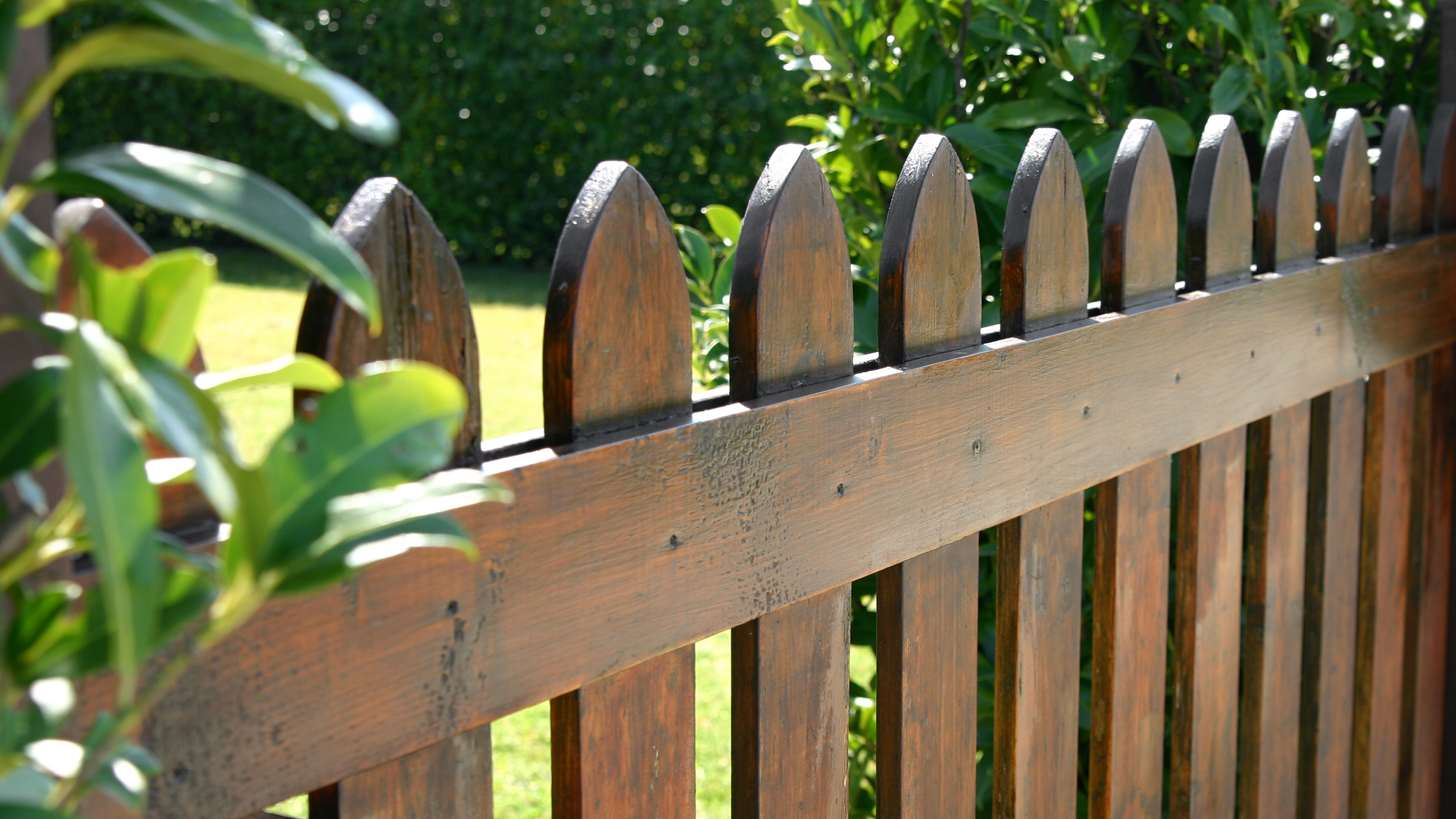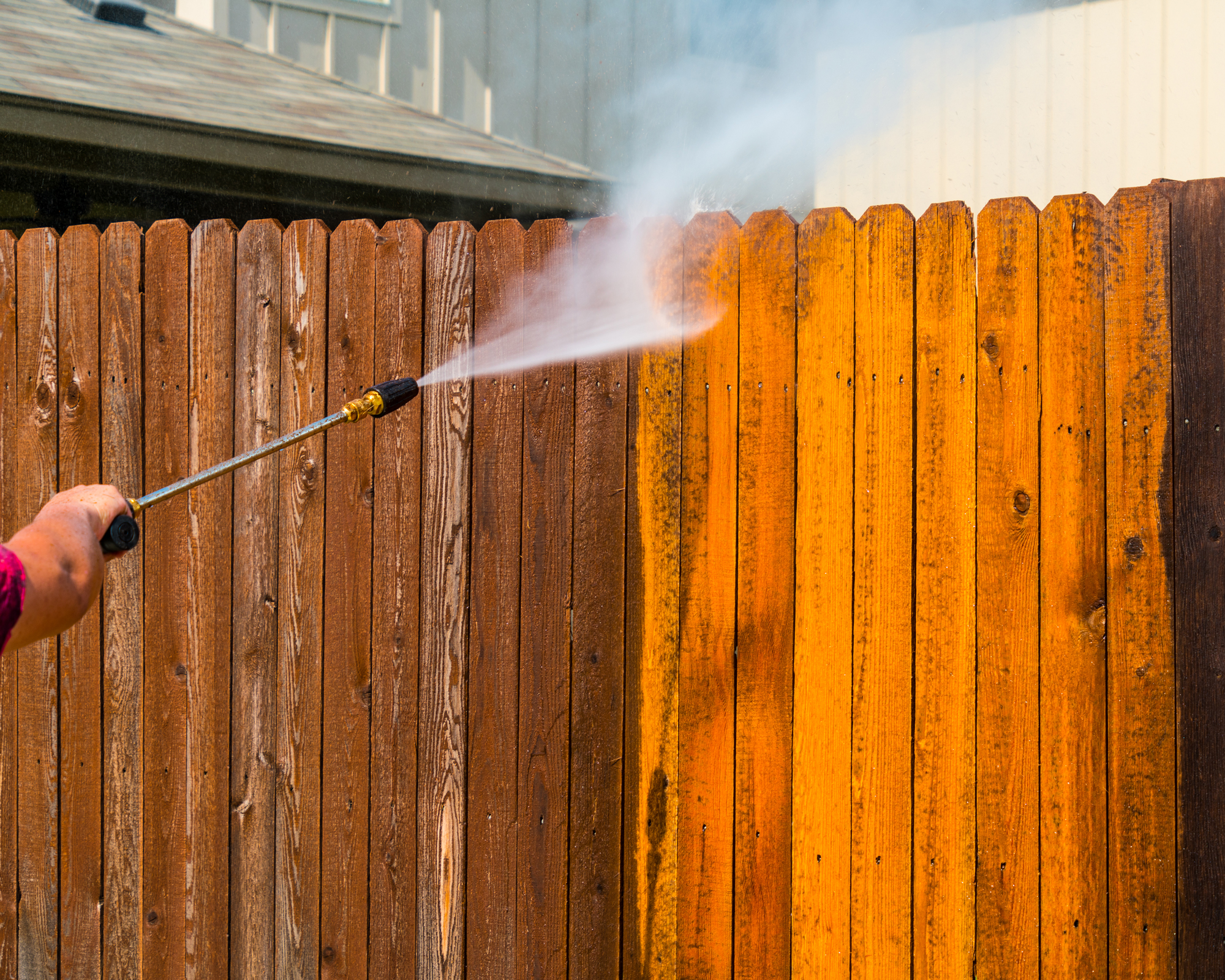How to clean a wooden fence (even without a pressure washer)
Find out how to clean a wooden fence and give yours a new lease of life this spring

Learning how to clean a wooden fence is all about finding the right approach for the specific type of dirt or stain that has affected your outdoor fencing. The main problems that affect wooden fences are dirt, algae growth, and mold. If your fence is north-facing and you live in a cool, humid climate, then you're more likely to have these issues.
Of course, applying the best fence stain regularly will reduce the need for cleaning. If your fence is untreated, however, now is the time to give it a thorough clean before protecting it with a stain. Here's how.
Can I clean a wooden fence without a pressure washer?
You've probably heard about the magical powers of the best pressure washers when it comes to outdoor cleaning. Indeed, if you have one then you may well be able to get your fence clean again without the need for any other methods. A pressure washer or power washer mechanically removes any buildup on your fence with the strong jet of water – it basically just pushes everything off the surface of the wood.
What if you don't have a pressure washer, though? Don't worry – there are plenty of other methods for cleaning wooden fences. They have been tried and tested by professionals who regularly work with wood, so they will be just as effective, even if you will have to put in a little bit more time and effort into them.

1. Start with just water
Got a garden hose? You've got everything you need to clean your fence, in a large number of cases. Goodell David, a woodworking professional and Founder of WoodWorkingClarity, swears by simply using your garden hose to remove dirt from your fence – 'the water can also help to restore the original color of the fence by rinsing off the dirt that has discolored the wood.'
Top tip: if you have a lot of buildup on your fence, David recommends using 'a scraper to remove as much of the dirt as possible' before hosing it down. A DIY scraper can be bought on Amazon.
A thorough hose down is also a great time to check your fence for splinters; if you see any, 'the fence needs to be sanded down in order to remove any loose pieces of wood.'
Get small space home decor ideas, celeb inspiration, DIY tips and more, straight to your inbox!
2. Try a little soap
Water not quite doing the trick? Just add a bit of liquid soap or dish soap to warm water. Lindsey Hyland, the founder of Urban Organic Yield, advises 'filling up your pail with soapy water and adding in some soft-bristled brushes. Next, rinse the whole thing off using a garden hose before letting it dry overnight or during any other time that you're not working on projects around your home!'
Top tip: If you have some Castile soap at home, use it – it works wonders for cleaning wood.
3. Use vinegar for algae and stains
Vinegar is a household cleaning wonder and it works very well for wooden fences – especially if yours has been affected by green algae or has brown spots on it. For green algae, Hyland recommends using a ratio of one part white vinegar to four parts water: 'spray the solution on the algae, then scrub it away with a brush or rubbing pad. Allow for an entire drying period before applying any sealant or paint.'
For brown spots, mix one gallon of white vinegar with one gallon of water in a bucket. 'Dip a scrub brush into the mixture and scrub the spots/mold away. Rinse the fence with a hose to remove any remaining residue.'
4. Use a bleach solution
For very tough algae buildup or mold spots, you may have to bring out the household bleach. David urges caution: 'bleach is a powerful cleaning agent that will make the algae easier to scrub, but it can also damage some of your fence.' So, rather than covering your entire fence with the bleach, 'soak the affected area with a solution of one to two teaspoons of bleach in a gallon of water. Scrub the fence with a stiff brush to remove any debris, and then rinse it with clear water.'
Top tip: 'Be careful when working with bleach as it is harmful to plants and animals, and to humans as well. Dispose of the bleach and any rags used to clean the fence in an outdoor trash bin that is not used for food preparation, and then wash the bleach off your hands and arms with soap and water.'
5. Remove algae buildup with a scrub brush
Sometimes, mechanical removal is far more effective than using chemicals. Use this method especially if you notice textured algae and/or moss growth on your fence. The best thing to use here, according to David is a scrub brush – 'the bristles on a scrub brush are stiffer and stronger than the bristles on a regular household brush. It is much easier to remove green algae with a brush in comparison to scrubbing with a pad.'
To use this method, soak the scrub brush with a solution of water and vinegar and scrub the green algae with the brush. Once all the green algae come loose, rinse the fence with a gentle jet of hose water.
Top tip: We like using a deck scrub brush from Amazon for cleaning fences.
6. Sand off tough stains
If you have mold on your fence and it has established itself inside the wood, you may need to take a more drastic approach and physically remove the top layer of the wood to get rid of the staining. David says: 'you will need to sand it off. You can do this by using sandpaper or a sander. A sander will be faster and easier, but if you don't have access to a sander, sanding by hand will get the job done too.'
7. Try an outdoor cleaner
If you have some decking cleaner leftover from cleaning your deck, or a multi-purpose outdoor cleaner, there's no reason you can't try it on your fence.
Jan Walter, Founder of exterior painting business Gocolorize.com, recommends the following method:
- Mixing your outdoor cleaner' with water in a bucket according to the instructions on the bottle, or mix it into a garden sprayer.
- Then, spray on the mixture, or by using a stiff paintbrush, apply the mixture to the fence and brush it in well.
- Allow the cleaner to sit on the fence for about 5-10 minutes so that it can do its job.
- Finally, rinse off the fence with a hose or use a bucket of clean water and a sponge to rinse it off thoroughly.

7. Treat the fence to prevent further problems
You've cleaned the fence and let it dry thoroughly. Now is the time to apply a protective stain or a wood preservative from Amazon to prevent a reoccurrence of algae and/or mold. Choose a dry weekend to apply the fence treatment, or your effort will be for nothing. Learn how to stain a fence and you won't need to clean it as much.
What is the best way to remove black mold from a wooden fence?
Mold is on the more serious side of fence problems – if you don't do anything about it, it will penetrate so deep into the wood, likely ruining your yard fencing so that eventually you'll have to replace the entire thing.
The best method here is to use a bleach solution. David recommends applying the mixture with a spray bottle and a cloth. 'Be sure to soak the mold/mildew, but not the wood itself. Allow the bleach-water solution to sit on the mold/mildew for at least 30 minutes. After 30 minutes, use a clean cloth to wipe the bleach-water solution and mold/mildew from the wood. Repeat this process until all mildew/mold is removed.'
Top tip: 'Be sure to use a bleach that only contains 5% hypochlorite in order to protect the wood.'
Jeremy Yamaguchi, CEO of Lawn Love comments on removing mold from a fence: 'When it comes to wooden fencing, mold is unfortunately not uncommon. Frequent exposure to moisture and bacteria makes wooden fences ideal locations for mold. Luckily, mold on your fence is not the end of the world and can usually be cleaned entirely.
Start by hosing the fence down with a regular hose to remove excess dirt and debris, then take a pressure washer and tackle the tough grime..It should cut through most of it. If it still needs to be cleaned more, a product that I really like for cleaning wooden fences and removing mildew/mold is Mold Armor, which you can order on Amazon. It’s specifically designed for deep cleaning wooden fences and decks, and it truly works very well. It comes in a spray, and after you apply it to your fence, you can let it sit for as long as you like before hosing it off. You can also scrub it into the fence if you want an extra deep clean, but that isn’t required for it to work effectively.
A precautionary step you can take to prevent mold is applying a sealant to your wooden fence from time to time.'
Anna is a professional writer with many years of experience. She has a passion for contemporary home decor and gardening. She covers a range of topics, from practical advice to interior and garden design.